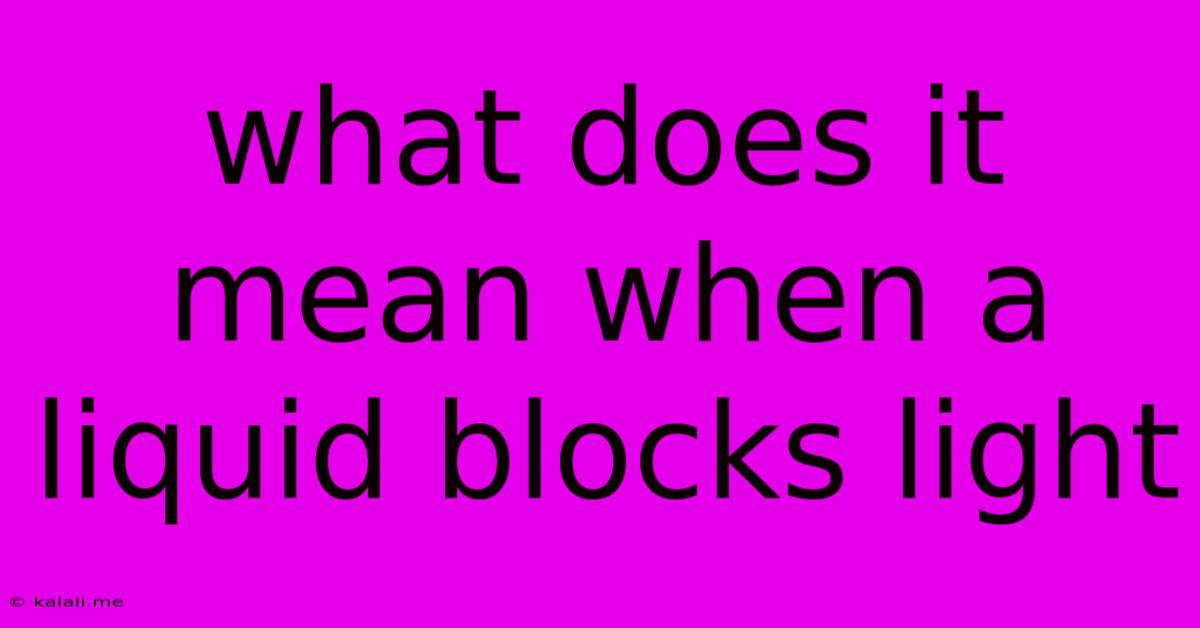What Does It Mean When A Liquid Blocks Light
Kalali
Jun 05, 2025 · 3 min read

Table of Contents
What Does It Mean When a Liquid Blocks Light? Understanding Light Absorption and Opacity in Liquids
When a liquid blocks light, it means the liquid is absorbing or scattering the light photons that pass through it. This phenomenon isn't about the liquid physically stopping the light like a solid wall, but rather about how the liquid interacts with the electromagnetic radiation that makes up light. This interaction determines the liquid's opacity, translucency, or transparency. Understanding these properties is crucial in various fields, from chemistry and physics to material science and even everyday life.
This article will explore the different factors that influence a liquid's ability to block light, the scientific principles behind it, and real-world examples.
The Science Behind Light Absorption and Scattering
Light absorption and scattering in liquids are primarily determined by the molecular structure and composition of the liquid. When light interacts with a liquid, several processes can occur:
-
Absorption: Molecules in the liquid can absorb specific wavelengths (colors) of light. This absorption excites the electrons in the molecules to higher energy levels. The absorbed light energy is often converted into other forms of energy, such as heat. For example, dark-colored liquids generally absorb more light across the visible spectrum than lighter-colored liquids.
-
Scattering: Light can also be scattered by the molecules in the liquid. This happens when light waves interact with particles in the liquid, causing them to change direction. The extent of scattering depends on the size and concentration of the particles. Liquids with suspended particles, like muddy water, will scatter light more significantly, appearing opaque. Rayleigh scattering, where shorter wavelengths (blue light) are scattered more efficiently than longer wavelengths (red light), is a prime example. This is why the sky appears blue.
-
Transmission: If a liquid doesn't absorb or scatter much light, it will transmit the light, appearing transparent or translucent. Pure water, for example, is relatively transparent because its molecules don't strongly absorb or scatter visible light.
Factors Affecting Light Blocking in Liquids
Several factors influence a liquid's ability to block light:
-
Concentration of dissolved substances: The higher the concentration of dissolved substances, the greater the chance of light absorption or scattering. A highly concentrated solution of a colored dye will be more opaque than a dilute solution.
-
Particle size and concentration: The presence of suspended particles significantly impacts light scattering. Larger particles scatter light more effectively than smaller particles. A higher concentration of particles will also lead to increased scattering.
-
Wavelength of light: Different wavelengths of light interact differently with the molecules in the liquid. Some wavelengths might be absorbed more strongly than others, leading to selective absorption and the appearance of color.
-
Liquid's temperature: Temperature can affect the molecular structure and motion, potentially influencing the absorption and scattering properties of the liquid.
Real-World Examples
Many everyday examples illustrate the principle of liquids blocking light:
-
Milk: Milk appears opaque due to the scattering of light by the fat globules and protein molecules suspended in the liquid.
-
Coffee: The dark color of coffee is a result of the absorption of light by the various organic compounds present.
-
Ocean water: The depth to which light penetrates ocean water depends on several factors, including the concentration of dissolved substances and suspended particles like sediment and plankton. Deeper waters appear darker due to increased light absorption and scattering.
-
Colored solutions: Solutions of dyes and pigments absorb specific wavelengths of light, resulting in their characteristic colors and varying degrees of opacity.
Conclusion
The ability of a liquid to block light is a complex phenomenon determined by its molecular structure, composition, and the presence of dissolved or suspended particles. Understanding the principles of light absorption and scattering is fundamental to various scientific disciplines and practical applications. By understanding these processes, we can better predict and control the optical properties of liquids in diverse fields.
Latest Posts
Latest Posts
-
Linear Regression How To Do Residual Analysis R
Jun 07, 2025
-
Can Stone Pick Mine Diamond Blocks
Jun 07, 2025
-
How Do You Sell A Gun Legally
Jun 07, 2025
-
I Used The Stones To Destroy The Stones
Jun 07, 2025
-
Inverting Amplifier And Non Inverting Amplifier
Jun 07, 2025
Related Post
Thank you for visiting our website which covers about What Does It Mean When A Liquid Blocks Light . We hope the information provided has been useful to you. Feel free to contact us if you have any questions or need further assistance. See you next time and don't miss to bookmark.